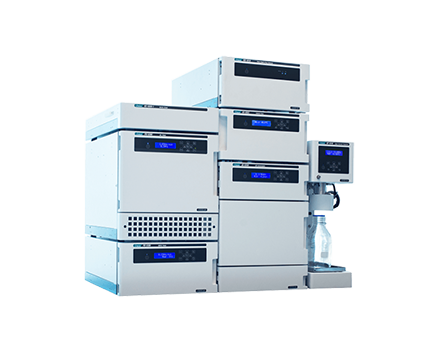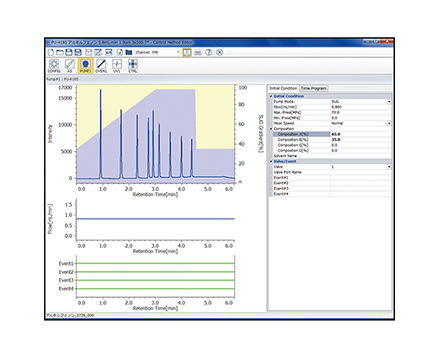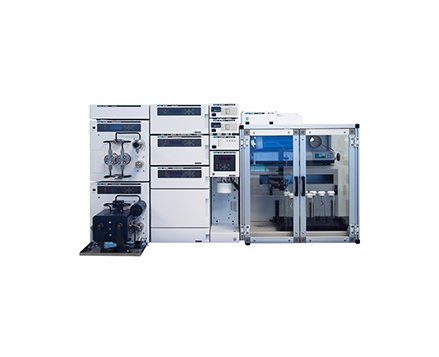Supercritical Fluid Extraction of Residual Pesticides in Spinach
February 27, 2024
Introduction
Supercritical Fluid Extraction of Residual Pesticides
The extraction of residual pesticides in foods has been typically been performed by solvent extraction . This method, however, takes approx. 4 – 5 hours per extraction, and requires large quantities of organic solvent. In recent years, supercritical fluid extraction (SFE) using supercritical carbon dioxide has attracted much attention as an alternative method to the solvent extraction method.
JASCO has developed a fully automated residual pesticide extraction system, and applied this system to the analysis of a spinach sample. Extracted components were analyzed by GC-MS/MS.
Experimental
The fully automated residual pesticide extraction system was used for this application. A schematic of the system is shown in Figure 1.
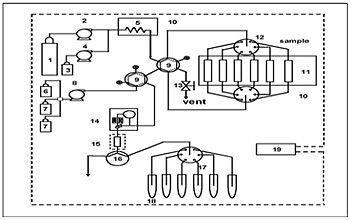
System configuration: 1 = carbon dioxide cylinder, 2 = liquefied carbon dioxide delivery pump, 3 = modifier, 4 = modifier delivery pump, 5 = preheating coil, 6 = solvent for trap elution, 7 = rinse solution for trap column, 8 = solvent delivery pump, 9 = switching valve for flow line, 10 = oven, 11 = extraction vessels, 12 = 6-vessel changer, 13 = release valve, 14 = automatic back pressure regulator, 15 = trap column, 16 = 3-way valve, 17 = 6-way flow line switching valve, 18 = collection tubes, 19 = system controller. Supercritical CO2 delivered by pump 2 passes through one of vessels 11 in which the sample is loaded and then pesticides are extracted. The extracted pesticides are concentrated by a trap column, is eluted by acetonitrile (2 mL) delivered by pump 8, and is collected in one of collection tubes 18. This system is automatically controlled by 19, system controller.
Supercritical fluid extraction conditions:
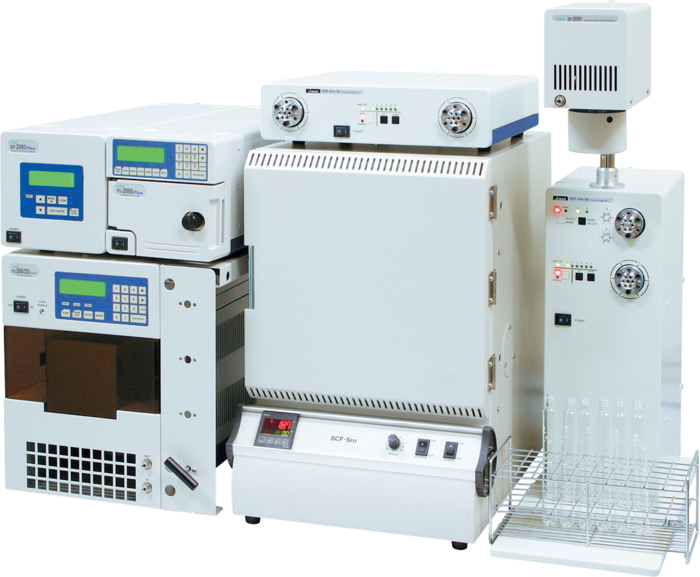
extraction tube : 10 mL (10 mm x 127 mm), supercritical fluid : CO2, back pressure = 15 MPa, extraction time : 30 min, flow rate : 2mL/min, trap column : ODS (4.6 mm x 50 mm, 30 µm), solvent for trap elution : acetonitrile 2 mL (flow rate : 2mL/min).
As an analytical sample, spinach was selected. Sixty-eight kinds of pesticides were added to the spinach to be a concentration of 0.1 ppm for each pesticide except captan, 1 ppm and acetamiprid, 0.5 ppm. Two grams of the spinach and 2 g of Hydromatrix (a dehydrating agent) were loaded in each extraction vessel; SFE was applied at an extraction pressure of 15 MPa, at an extraction temperature of 40°C, for an extraction time of 30 min; the extracted components were adsorbed on a trap column; the trapped components were eluted with acetonitrile; the acetonitrile solution was evaporated to dryness with nitrogen gas; and the residue was dissolved in 3 mL of acetone containing 0.05% of PEG200 and PEG400. A portion of this solution was injected onto the GC.
Keywords
residual pesticides, , SFE, supercritical fluid extractions
Results
Chromatograms of the standard mixture (upper), the sample added with the standard (middle), and the blank (lower) are shown in Figure 2.
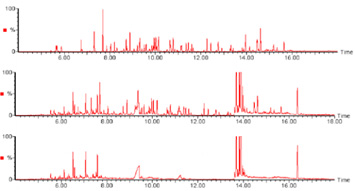
Upper : standard mixture (68 components)
Middle : sample added with standard mixture
Lower : blank Measurement conditions
Standard mixture solution contains 68 components as below:
1: Acephate, 2: Acetamiprid, 3: Bendiocarb, 4: Bitertanol, 5: Butylate, 6: Captan, 7: Carbaryl 8: Chinomethionat, 9: Chlorfenvinphos, 10: Chlorpyriphos, 11: Cyfluthrin, 12: Cypermethrin, 13: Deltamethrin, 14: Diazinon, 15: Dichlofluanid, 16: Dichlorvos, 17: Diethofencarb, 18: Dimethylvinphos, 19: EPN, 20: Esprocarb, 21: Ethiofencarb, 22: Ethoprophos, 23: Fenarimol, 24: Fenitrothin, 25: Fenobucarb, 26: Fensulfothion, 27: Fenvalerate, 28: Flucythrinate, 29: Flusilazole, 30: Flutolanil, 31: Fluvalinate, 32: Imibenconazole, 33: Iprodione, 34: Isofenphos , 35: Isofenphos P=O, 36: Isoprocarb, 37: Lenacil, 38: Malathion, 39: Mefenacet, 40: Mepronil, 41: Methamidophos, 42: Metolaclior, 43: p,p’-DDE, 44: Paclobutrazol, 45: Pencycuron, 46: Pendimethalin, 47: Permethalin, 48: Phenthoate, 49: Phosalone, 50: Pirimifos-methyl, 51: p,p’-DDD, 52: Pretilachlor, 53: Propiconazole, 54: Pyraclofos, 55: Pyridaben, 56: Pyridaphenthion, 57: Pyrimidifen, 58: Quinalphos, 59: Tefluthrin, 60: Terbucarb, 61: Terbufos, 62: Thenylchlor, 63: Tolclofos-methyl, 64: Triadimenol, 65: a-BHC, 66: ß-BHC, 67: ?-BHC, 68: d-BHC.
As shown in Table 1, among the 68 pesticides, 47 exhibited more than 70% recovery, and 61 more than 50% recovery. The recovery of acetamiprid and butylate was 20% and 45%, respectively. Acephate, captan, dichlofluanid, and methamidophos exhibited less than 10% recovery; their high hydrophilicity and adsorption on the dehydrating agent seemed to be responsible for a poor recovery in SFE.
| No. | Pesticide | Recovery (%) | No. | Pesticide | Recovery (%) |
|---|---|---|---|---|---|
| 1 | Acephate | 9.2 | 35 | Isofenphos P=O | 98.0 |
| 2 | Acetamiprid | 19.8 | 36 | Isoprocarb | 89.1 |
| 3 | Bendiocarb | 113.0 | 37 | Lenacil | 79.9 |
| 4 | Bitertanol | 64.0 | 38 | Malathion | 91.8 |
| 5 | Butylate | 45.1 | 39 | Mefenacet | 87.4 |
| 6 | Captan | 3.8 | 40 | Mepronil | 75.7 |
| 7 | Carbaryl | 130.5 | 41 | Methamidophos | 4.7 |
| 8 | Chinomethionat | 97.0 | 42 | Metolachlor | 97.7 |
| 9 | Chlorfenvinphos | 76.1 | 43 | p,p'-DDE | 71.7 |
| 10 | Chlorpyriphos | 84.0 | 44 | Paclobutrazol | 111.6 |
| 11 | Cyfluthrin | 59.1 | 45 | Pencycuron | 59.9 |
| 12 | Cypermethrin | 86.7 | 46 | Pendimethalin | 95.6 |
| 13 | Deltamethrin | 57.8 | 47 | Permethalin | 57.3 |
| 14 | Diazinon | 78.6 | 48 | Phenthoate | 77.0 |
| 15 | Dichlofluanid | 2.9 | 49 | Phosalone | 73.5 |
| 16 | Dichlorvos | 60.1 | 50 | Pirimifos-methyl | 90.2 |
| 17 | Diethofencarb | 101.5 | 51 | p,p'-DDD | 81.8 |
| 18 | Dimethylvinphos | 90.9 | 52 | Pretilachlor | 88.9 |
| 19 | EPN | 75.0 | 53 | Propiconazole | 76.1 |
| 20 | Esprocarb | 79.1 | 54 | Pyraclofos | 76.6 |
| 21 | Ethiofencarb | 44.1 | 55 | Pyridaben | 68.6 |
| 22 | Ethoprophos | 95.2 | 56 | Pyridaphenthion | 92.4 |
| 23 | Fenarimol | 73.0 | 57 | Pyrimidifen | 77.0 |
| 24 | Fenitrothion | 107.8 | 58 | Quinalphos | 82.9 |
| 25 | Fenobucarb | 89.0 | 59 | Tefluthrin | 64.5 |
| 26 | Fensulfothion | 101.6 | 60 | Terbucarb | 89.3 |
| 27 | Fenvalerate | 64.5 | 61 | Terbufos | 52.2 |
| 28 | Flucythrinate | 56.9 | 62 | Thenylchlor | 96.4 |
| 29 | Flusilazole | 86.5 | 62 | Tolclofos-methyl | 83.5 |
| 30 | Flutolanil | 92.1 | 64 | Triadimenol | 93.4 |
| 31 | Fluvalinate | 50.7 | 65 | a-BHC | 92.0 |
| 32 | Imibenconazole | 63.2 | 66 | ß-BHC | 92.7 |
| 33 | Iprodione | 105.4 | 67 | Y-BHC | 88.1 |
| 34 | Isofenphos | 57.1 | 68 | d-BHC | 106.4 |
Featured Products:

Supercritical Fluid Extraction of Residual Pesticides in Spinach
Introduction
Supercritical Fluid Extraction of Residual Pesticides
The extraction of residual pesticides in foods has been typically been performed by solvent extraction . This method, however, takes approx. 4 – 5 hours per extraction, and requires large quantities of organic solvent. In recent years, supercritical fluid extraction (SFE) using supercritical carbon dioxide has attracted much attention as an alternative method to the solvent extraction method.
JASCO has developed a fully automated residual pesticide extraction system, and applied this system to the analysis of a spinach sample. Extracted components were analyzed by GC-MS/MS.
Experimental
The fully automated residual pesticide extraction system was used for this application. A schematic of the system is shown in Figure 1.

System configuration: 1 = carbon dioxide cylinder, 2 = liquefied carbon dioxide delivery pump, 3 = modifier, 4 = modifier delivery pump, 5 = preheating coil, 6 = solvent for trap elution, 7 = rinse solution for trap column, 8 = solvent delivery pump, 9 = switching valve for flow line, 10 = oven, 11 = extraction vessels, 12 = 6-vessel changer, 13 = release valve, 14 = automatic back pressure regulator, 15 = trap column, 16 = 3-way valve, 17 = 6-way flow line switching valve, 18 = collection tubes, 19 = system controller. Supercritical CO2 delivered by pump 2 passes through one of vessels 11 in which the sample is loaded and then pesticides are extracted. The extracted pesticides are concentrated by a trap column, is eluted by acetonitrile (2 mL) delivered by pump 8, and is collected in one of collection tubes 18. This system is automatically controlled by 19, system controller.
Supercritical fluid extraction conditions:

extraction tube : 10 mL (10 mm x 127 mm), supercritical fluid : CO2, back pressure = 15 MPa, extraction time : 30 min, flow rate : 2mL/min, trap column : ODS (4.6 mm x 50 mm, 30 µm), solvent for trap elution : acetonitrile 2 mL (flow rate : 2mL/min).
As an analytical sample, spinach was selected. Sixty-eight kinds of pesticides were added to the spinach to be a concentration of 0.1 ppm for each pesticide except captan, 1 ppm and acetamiprid, 0.5 ppm. Two grams of the spinach and 2 g of Hydromatrix (a dehydrating agent) were loaded in each extraction vessel; SFE was applied at an extraction pressure of 15 MPa, at an extraction temperature of 40°C, for an extraction time of 30 min; the extracted components were adsorbed on a trap column; the trapped components were eluted with acetonitrile; the acetonitrile solution was evaporated to dryness with nitrogen gas; and the residue was dissolved in 3 mL of acetone containing 0.05% of PEG200 and PEG400. A portion of this solution was injected onto the GC.
Keywords
residual pesticides, , SFE, supercritical fluid extractions
Results
Chromatograms of the standard mixture (upper), the sample added with the standard (middle), and the blank (lower) are shown in Figure 2.

Upper : standard mixture (68 components)
Middle : sample added with standard mixture
Lower : blank Measurement conditions
Standard mixture solution contains 68 components as below:
1: Acephate, 2: Acetamiprid, 3: Bendiocarb, 4: Bitertanol, 5: Butylate, 6: Captan, 7: Carbaryl 8: Chinomethionat, 9: Chlorfenvinphos, 10: Chlorpyriphos, 11: Cyfluthrin, 12: Cypermethrin, 13: Deltamethrin, 14: Diazinon, 15: Dichlofluanid, 16: Dichlorvos, 17: Diethofencarb, 18: Dimethylvinphos, 19: EPN, 20: Esprocarb, 21: Ethiofencarb, 22: Ethoprophos, 23: Fenarimol, 24: Fenitrothin, 25: Fenobucarb, 26: Fensulfothion, 27: Fenvalerate, 28: Flucythrinate, 29: Flusilazole, 30: Flutolanil, 31: Fluvalinate, 32: Imibenconazole, 33: Iprodione, 34: Isofenphos , 35: Isofenphos P=O, 36: Isoprocarb, 37: Lenacil, 38: Malathion, 39: Mefenacet, 40: Mepronil, 41: Methamidophos, 42: Metolaclior, 43: p,p’-DDE, 44: Paclobutrazol, 45: Pencycuron, 46: Pendimethalin, 47: Permethalin, 48: Phenthoate, 49: Phosalone, 50: Pirimifos-methyl, 51: p,p’-DDD, 52: Pretilachlor, 53: Propiconazole, 54: Pyraclofos, 55: Pyridaben, 56: Pyridaphenthion, 57: Pyrimidifen, 58: Quinalphos, 59: Tefluthrin, 60: Terbucarb, 61: Terbufos, 62: Thenylchlor, 63: Tolclofos-methyl, 64: Triadimenol, 65: a-BHC, 66: ß-BHC, 67: ?-BHC, 68: d-BHC.
As shown in Table 1, among the 68 pesticides, 47 exhibited more than 70% recovery, and 61 more than 50% recovery. The recovery of acetamiprid and butylate was 20% and 45%, respectively. Acephate, captan, dichlofluanid, and methamidophos exhibited less than 10% recovery; their high hydrophilicity and adsorption on the dehydrating agent seemed to be responsible for a poor recovery in SFE.
| No. | Pesticide | Recovery (%) | No. | Pesticide | Recovery (%) |
|---|---|---|---|---|---|
| 1 | Acephate | 9.2 | 35 | Isofenphos P=O | 98.0 |
| 2 | Acetamiprid | 19.8 | 36 | Isoprocarb | 89.1 |
| 3 | Bendiocarb | 113.0 | 37 | Lenacil | 79.9 |
| 4 | Bitertanol | 64.0 | 38 | Malathion | 91.8 |
| 5 | Butylate | 45.1 | 39 | Mefenacet | 87.4 |
| 6 | Captan | 3.8 | 40 | Mepronil | 75.7 |
| 7 | Carbaryl | 130.5 | 41 | Methamidophos | 4.7 |
| 8 | Chinomethionat | 97.0 | 42 | Metolachlor | 97.7 |
| 9 | Chlorfenvinphos | 76.1 | 43 | p,p'-DDE | 71.7 |
| 10 | Chlorpyriphos | 84.0 | 44 | Paclobutrazol | 111.6 |
| 11 | Cyfluthrin | 59.1 | 45 | Pencycuron | 59.9 |
| 12 | Cypermethrin | 86.7 | 46 | Pendimethalin | 95.6 |
| 13 | Deltamethrin | 57.8 | 47 | Permethalin | 57.3 |
| 14 | Diazinon | 78.6 | 48 | Phenthoate | 77.0 |
| 15 | Dichlofluanid | 2.9 | 49 | Phosalone | 73.5 |
| 16 | Dichlorvos | 60.1 | 50 | Pirimifos-methyl | 90.2 |
| 17 | Diethofencarb | 101.5 | 51 | p,p'-DDD | 81.8 |
| 18 | Dimethylvinphos | 90.9 | 52 | Pretilachlor | 88.9 |
| 19 | EPN | 75.0 | 53 | Propiconazole | 76.1 |
| 20 | Esprocarb | 79.1 | 54 | Pyraclofos | 76.6 |
| 21 | Ethiofencarb | 44.1 | 55 | Pyridaben | 68.6 |
| 22 | Ethoprophos | 95.2 | 56 | Pyridaphenthion | 92.4 |
| 23 | Fenarimol | 73.0 | 57 | Pyrimidifen | 77.0 |
| 24 | Fenitrothion | 107.8 | 58 | Quinalphos | 82.9 |
| 25 | Fenobucarb | 89.0 | 59 | Tefluthrin | 64.5 |
| 26 | Fensulfothion | 101.6 | 60 | Terbucarb | 89.3 |
| 27 | Fenvalerate | 64.5 | 61 | Terbufos | 52.2 |
| 28 | Flucythrinate | 56.9 | 62 | Thenylchlor | 96.4 |
| 29 | Flusilazole | 86.5 | 62 | Tolclofos-methyl | 83.5 |
| 30 | Flutolanil | 92.1 | 64 | Triadimenol | 93.4 |
| 31 | Fluvalinate | 50.7 | 65 | a-BHC | 92.0 |
| 32 | Imibenconazole | 63.2 | 66 | ß-BHC | 92.7 |
| 33 | Iprodione | 105.4 | 67 | Y-BHC | 88.1 |
| 34 | Isofenphos | 57.1 | 68 | d-BHC | 106.4 |

 Download This Application
Download This Application